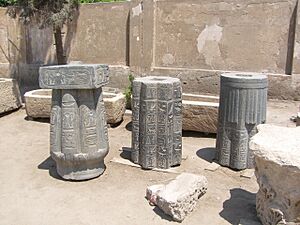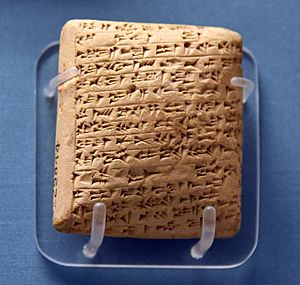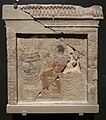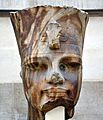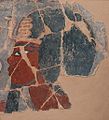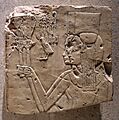Amenhotep III facts for kids
Quick facts for kids Amenhotep III |
|
|---|---|
| Nibmu(`w)areya, Mimureya, Amenophis III | |
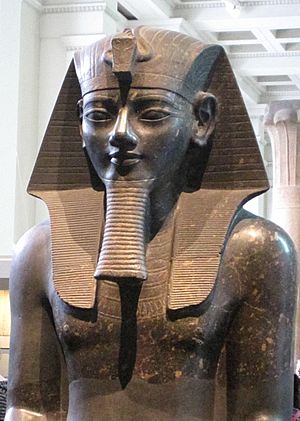
A statue of Amenhotep III in the British Museum
|
|
| Pharaoh | |
| Reign | 1391–1353 BC or 1388–1351 BC (18th Dynasty) |
| Predecessor | Thutmose IV |
| Successor | Akhenaten |
| Consort | Tiye Gilukhepa Tadukhepa Sitamun Iset |
| Children | Thutmose Amenhotep IV/Akhenaten Sitamun Iset Henuttaneb Nebetah "The Younger Lady" Beketaten (theorized) Smenkhkare (theorized) |
| Father | Thutmose IV |
| Mother | Mutemwiya |
| Died | 1353 BC or 1351 BC (aged c. 45) |
| Burial | WV22; Mummy found in the KV35 royal cache (Theban Necropolis) |
| Monuments | Malkata, Mortuary Temple of Amenhotep III, Colossi of Memnon |
Amenhotep III (which means "Amun is satisfied") was one of ancient Egypt's greatest pharaohs. He was the ninth king of the powerful Eighteenth Dynasty. He is often called Amenhotep the Magnificent because his rule was a time of great peace, wealth, and amazing art.
During his reign, Egypt became richer and more powerful than ever before. He was a master of diplomacy, which means he was good at building relationships with other countries. He was also a great builder who created some of Egypt's most famous monuments. He ruled for nearly 40 years (from about 1388 to 1351 BC). When he died, he was succeeded by his son, Amenhotep IV, who later changed his name to Akhenaten.
Contents
Family and Early Life
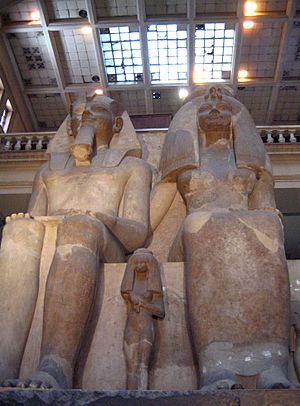
Amenhotep III was the son of Pharaoh Thutmose IV and his wife, Queen Mutemwiya. He was probably born around 1401 BC and became pharaoh when he was just a child, between the ages of 6 and 12.
To show his special connection to the gods, Amenhotep had scenes of his "divine birth" carved in the Luxor Temple. These carvings told a story that his real father was the great god Amun, who visited his mother in the form of her husband. This was a way to show that he was chosen by the gods to rule Egypt.
When he was young, Amenhotep married Tiye, who became his Great Royal Wife and was very powerful and important throughout his reign. Together, they had several children, including:
- Crown Prince Thutmose, their oldest son, who died before he could become pharaoh.
- Amenhotep IV, their second son, who became the next pharaoh and changed his name to Akhenaten.
- Several daughters, including Sitamun, Henuttaneb, and Iset.
To build friendships with other kingdoms, Amenhotep also married princesses from foreign lands, such as Mitanni and Babylon.
A Peaceful and Prosperous Reign
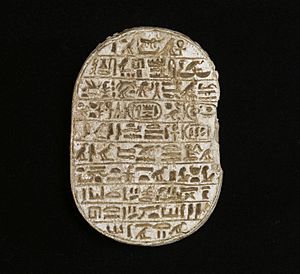
Amenhotep III's time as pharaoh was mostly peaceful. Instead of fighting big wars, he focused on building, art, and diplomacy.
A Young King's Adventures
Early in his reign, Amenhotep wanted to show his strength and bravery. Special carved stones called scarabs tell us that he hunted over 100 lions in his first ten years as king.
He only led one military campaign. In his fifth year as king, he traveled south to Kush (also called Nubia) to stop a rebellion. He won easily, which helped secure Egypt's control over the region's valuable gold mines.
Royal Court and Officials
Amenhotep had many skilled officials to help him rule. His top advisors were called viziers. One of the most famous people in his court was Amenhotep, son of Hapu. He was so wise and respected that after he died, the Egyptians worshipped him as a god, which was a very rare honor for someone who was not royal.
The Great Builder
Amenhotep III was one of the greatest builders in Egyptian history. He built and expanded many temples and palaces.
The Palace of the Dazzling Sun
He built a huge palace complex called Malkata on the west bank of the Nile at Thebes. Its ancient name meant "House of Rejoicing." The palace was so grand that it was also called "the Dazzling Aten." It was the largest royal home in Egypt and was where the king lived for much of his rule.
Temples and Statues
Amenhotep's building projects were all over Egypt. His most famous works include:
- The Mortuary Temple: This was the king's temple for worship after his death. In its time, it was the largest temple in Thebes. Sadly, it was built too close to the Nile river, and floods eventually ruined it.
- The Colossi of Memnon: Two massive stone statues of Amenhotep III sitting on his throne still stand today. They were once the entrance to his mortuary temple. Each statue is about 18 meters (60 feet) tall!
- Luxor Temple: He added a beautiful colonnaded hall and a new entrance to this famous temple.
- Karnak Temple: He also built extensively at the great temple of Amun at Karnak, adding a new grand entrance, called a pylon.
Amenhotep had more statues of himself made than any other pharaoh. Over 250 of his statues have been found.
Celebrating the King: The Sed Festivals
Amenhotep III celebrated three Sed festivals, which were special celebrations for a king who had ruled for 30 years. These festivals were meant to show that the pharaoh was still strong and fit to rule.
The festivals were huge events that could last for months. They included many ceremonies and rituals. One of the most important parts was a dual coronation, where the king was crowned once as the ruler of Upper Egypt and again as the ruler of Lower Egypt. After his Sed festivals, Amenhotep was seen as more than just a king; he was considered a living god.
Egypt's Place in the World
During Amenhotep's reign, Egypt was a superpower. The pharaoh exchanged letters with other great kings from places like Babylon, Assyria, and the Hittite kingdom. These messages, known as the Amarna Letters, were written on clay tablets.
The letters show that other rulers respected Egypt's power and wealth. They often wrote to Amenhotep asking for gifts of gold, because Egypt was famous for having so much of it. Amenhotep also made alliances by marrying foreign princesses. However, he believed Egyptian princesses were too important to be sent to other countries, so he never let his daughters marry foreign rulers.
Final Years and Burial
Amenhotep III ruled for about 38 years. An examination of his mummy shows that in his later years, he had health problems, including painful teeth and arthritis. He likely died when he was between 40 and 50 years old.
He was buried in the Valley of the Kings in a large tomb now known as WV22. Like many royal mummies, his was moved long ago by priests to protect it from tomb robbers. It was rediscovered in 1898 in a hidden mummy cache in tomb KV35.
In 2021, the mummy of Amenhotep III was moved to its current home, the National Museum of Egyptian Civilization in Cairo, as part of a grand event called the Pharaohs' Golden Parade.
Family Tree
| Ancestors of Amenhotep III | ||||||||||||||||||||||||||||||||||||||||||||||||||||||||||||||||||||||||||||||||||||||||||||||||||||||||||||||||||||||||||||||||||||||||||||||||||||||||||||||||||||||||||||||||||||||||||||||||||||||||||||||||||||||||||||||||||||||
|---|---|---|---|---|---|---|---|---|---|---|---|---|---|---|---|---|---|---|---|---|---|---|---|---|---|---|---|---|---|---|---|---|---|---|---|---|---|---|---|---|---|---|---|---|---|---|---|---|---|---|---|---|---|---|---|---|---|---|---|---|---|---|---|---|---|---|---|---|---|---|---|---|---|---|---|---|---|---|---|---|---|---|---|---|---|---|---|---|---|---|---|---|---|---|---|---|---|---|---|---|---|---|---|---|---|---|---|---|---|---|---|---|---|---|---|---|---|---|---|---|---|---|---|---|---|---|---|---|---|---|---|---|---|---|---|---|---|---|---|---|---|---|---|---|---|---|---|---|---|---|---|---|---|---|---|---|---|---|---|---|---|---|---|---|---|---|---|---|---|---|---|---|---|---|---|---|---|---|---|---|---|---|---|---|---|---|---|---|---|---|---|---|---|---|---|---|---|---|---|---|---|---|---|---|---|---|---|---|---|---|---|---|---|---|---|---|---|---|---|---|---|---|---|---|---|---|---|---|---|---|
|
||||||||||||||||||||||||||||||||||||||||||||||||||||||||||||||||||||||||||||||||||||||||||||||||||||||||||||||||||||||||||||||||||||||||||||||||||||||||||||||||||||||||||||||||||||||||||||||||||||||||||||||||||||||||||||||||||||||
Gallery
-
Granodiorite seated statue of Amenhotep at the British Museum, from its left side.
-
Granodiorite statue of Amenhotep at the British Museum, Left of Statue above.
-
Granodiorite Amenhotep (Left Statue) Close up, British Museum
-
Bulls Tail (Left Statu e), British Museum
-
Belt (Left Statue), British Museum
-
Feet (Left Statue), British Museum
-
Left Inscriptions (Left Statue), British Museum
-
Right Inscriptions (Left Statue), British Museum
-
Red Granite Statue, North East side, British Museum
-
Limestone Amenhotep, British Museum
-
Amenhotep III from KV 22 tomb of Amenhotep III Louvre Museum N 521 A, Other inventory number: LP 2114
-
Fragment of a tomb relief depicting two princesses (daughters of Amenhotep III) with sistra. TT 192, Tomb of Kheruef Collections of the Egyptian Museum and Papyrus Collection of Berlin
-
A statue head of Amenhotep III collected by the Cleveland Museum of Art. The image was created during his reign.
-
Amenhotep and Sobek, from Dahamsha, now in the Luxor Museum
See also
 In Spanish: Amenofis III para niños
In Spanish: Amenofis III para niños
- Colossal red granite statue of Amenhotep III
- Colossal quartzite statue of Amenhotep III
- History of ancient Egypt
- Eighteenth dynasty of Egypt Family Tree
- List of pharaohs


